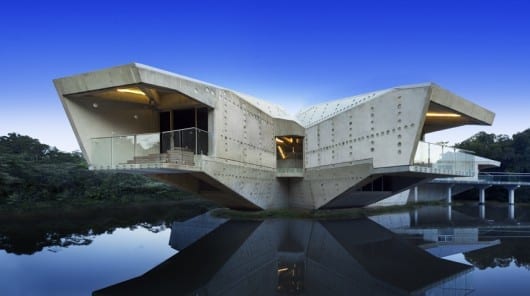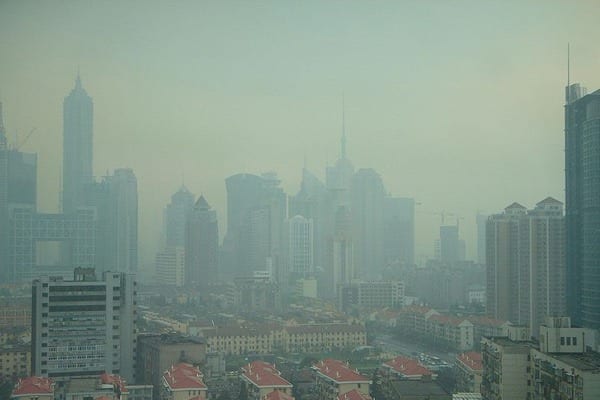
An excellent example of sustainable housing
Thanks to its tropical climate, Far North Queensland (FNQ), Australia, is a place where residents regularly have to deal with threats from the environment in the form of cyclones, while being mindful of their impact on the environment. One architectural firm has constructed a building that attempts to address both concerns simultaneously. Designed by Charles Wright Architects, the Stamp House in FNQ is a self-sustaining home that’s sturdy enough to withstand a Category 5 cyclone.
CWA built the house for a client with the goal of creating a self-sustaining structure that made good use of the surrounding wetland at the building site. The designers worked with local environmental groups, like the Department of Environment and Resource Management and the Queensland Parks and Wildlife Service, to ensure the project’s water system did not interfere with the natural ecosystem.
Constructed on a small patch of land in the middle of a pond, much of the Stamp House is comprised of a mixture of new and used concrete, which provides insulation to keep the temperature more constant throughout the year. The blueprints show two floors with seven bedrooms protruding from a larger living space that includes a kitchen/dining area, an open gym area, a few lounges, and several reflective ponds around a central pool.
Power is provided by solar panels that almost completely cover the roof and which are backed up by a solar-powered generator, eliminating the need for any fossil fuels to produce energy. Visitors reach the house on a raised walkway that stretches over the pond waters to dry land.
The Stamp House’s main eco-friendly feature, though, is it’s expansive water system, which is capable of harvesting up to 250,000 liters of water for home use and irrigation. Water used by occupants is recycled right back into the system and the site even has its own tertiary sewage treatment plant. All of the required mechanical and hydraulic facilities are cooled by a self-contained thermal storage tank system and are controlled with a C-Bus home automation protocol.
The Latest Bing News on:
Cyclone shelter
- Storm Reports: Tracking severe weather in Kansas Saturdayon April 27, 2024 at 10:15 am
Cover your head. Keep in your shelter until the storm has passed. If you have a weather radio, now is the time to make sure you have fresh batteries and stay tuned to know what is happening. Tune in ...
- Tornado Preparedness tips as peak storm season rolls aroundon April 27, 2024 at 12:08 am
Severe weather is at its peak here in Spring time over the Ark-La-Miss. Tornadoes have the potential to strike at any moment if the conditions and atmospheric ingredients are there. Based on previous ...
- Waverly family recounts moments powerful storm rolled throughon April 26, 2024 at 8:28 pm
Northeast Lancaster County was slammed by storms Friday afternoon and homeowners are just starting to assess the damage.
- 'It's about accessibility to shelter': Homeless man's tiny home built on railroad propertyon April 26, 2024 at 6:10 pm
Todd, who has been unhoused since 2007, lives in a self-built tiny home in a homeless encampment near Seneca Road.
- 'I was frankly terrified:' 400 shoppers shelter in restrooms, horse stalls at Lincoln plant saleon April 26, 2024 at 5:02 pm
More than 400 shoppers were forced to shelter for nearly two hours at the Spring Affair Plant Sale on Friday by the outbreak of tornadoes in the Waverly area.
- Red Cross sets up shelters to provide aid in Elkhorn and Blair; where to report tornado damageon April 26, 2024 at 4:45 pm
The Red Cross is setting up at Arbor View Elementary in Elkhorn to provide aid for those affected by the tornado and severe weather in the area.
- Watch: Massive tornado crosses Nebraska interstate, residents told to see shelteron April 26, 2024 at 3:20 pm
As weather officials urged eastern Nebraska residents to seek shelter, a massive tornado was spotted on Friday moving through Lincoln and Omaha metro areas.
- Storm reports: Tornado watch issued for parts of Kansason April 26, 2024 at 1:14 pm
There is a tornado watch issued for parts of northeast Kansas and southeast Kansas, including Cowley, Greenwood, Elk, Chautauqua, and Lyon County, until 9 p.m. Tornado warnings were issued for ...
- Severe storm season is here: How to stay safe during heavy rain, lightning and tornadoeson April 26, 2024 at 8:18 am
Experts say to stock up, pay close attention to weather warnings and stay off the roads as increasingly severe weather sweeps the U.S. in the spring.
- Oklahoma first responders urge people to register storm shelters amid severe weather seasonon April 25, 2024 at 12:48 pm
Ahead of the most recent storm risk, first responders have asked people statewide to do one thing that could be life-saving: register your storm shelter no matter where you live.
The Latest Google Headlines on:
Cyclone shelter
[google_news title=”” keyword=”cyclone shelter” num_posts=”10″ blurb_length=”0″ show_thumb=”left”] [/vc_column_text]The Latest Bing News on:
Sustainable housing
- Blueprints for Tomorrow: Crafting Sustainable Urban Growth for a Resilient Futureon April 26, 2024 at 11:25 pm
This article explores the vital strategies and policies needed for sustainable urban growth, highlighting the importance of resilient city planning that incorporates environmental and social ...
- Green Metropolises: Navigating the Path to Sustainable Urban Growth Globallyon April 26, 2024 at 11:25 pm
This article delves into the critical strategies and practices necessary for achieving sustainable urban growth globally. It underscores the importance of integrating technology, strategic planning, ...
- Lack of affordable housing is a big issue Valley wideon April 26, 2024 at 5:20 pm
Tony Johnson may not have a roof over his head or a door to close at night, but he won’t have you calling him homeless. The 64-year-old has been out on the street for the last few months, ...
- Blumenthal Pushes $234 Billion Zero-Carbon Public Housing Billon April 26, 2024 at 9:44 am
Richard Blumenthal announced his support this week for a federal bill that would invest over $200 billion in zero-carbon public housing called the Green New Deal For Public Housing Act. Blumenthal is ...
- Mumbai: Sustainable Housing Gives Real Estate Sector A Boost In MMRon April 26, 2024 at 7:43 am
While affordable homes, redeveloped structures and projects with ample amenities for elderly has been the talk of the town, it’s sustainable housing that has been making slow yet effective evolution ...
- HUD's Acting Secretary Lauds Philadelphia for Pioneering Green Affordable Housing During Earth Week Visiton April 26, 2024 at 6:11 am
Adrianne Todman visited Philadelphia, praising its efforts in sustainable affordable housing during Earth Week.
- The push for mass timber as a sustainable housing solution in New Englandon April 24, 2024 at 5:18 am
Across New England, some developers are trying to use a building method known as mass timber to inflict less environmental damage.
- Sustainable solutions: A look inside eco-friendly practices reshaping housing industryon April 23, 2024 at 4:01 am
With increasing awareness about environmental conservation and the pressing need to address climate change, developers, architects, and policymakers are reimagining the way buildings are designed, ...
- An off-the-grid community in New Mexico offers insight into sustainable buildingon April 22, 2024 at 8:09 am
In Taos, New Mexico, ABC News' Ginger Zee visits a community made of Earthships, a type of off-the-grid housing development aimed at sustainability.
- Eco Homes: 8 of the Most Sustainable Features to Consider, According to Expertson April 19, 2024 at 5:00 pm
The shape and size of your roof can also constitute effective passive design. Adding a large overhang allows light into your home during wintertime because the sun is at a higher angle, says Rodriguez ...
The Latest Google Headlines on:
Sustainable housing
[google_news title=”” keyword=”sustainable housing” num_posts=”10″ blurb_length=”0″ show_thumb=”left”]










